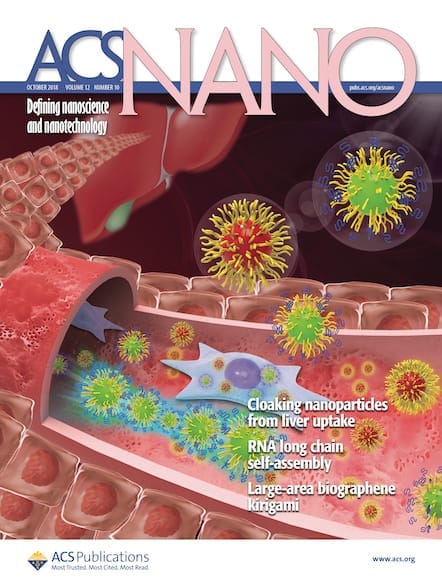Mucus is an important biological defense mechanism, but this also creates a barrier to drug delivery. Could new enzyme-powered nanobots help to deliver drugs these sticky situations?

Mucus is found in many places in the body, typically acting as a barrier where moist surfaces interface with the external environment—including our noses, lungs, stomach, intestines, and eyes. The primary structural component is mucin, a heavily glycosylated protein that forms a mesh-like gel using hydrogen bonds, disulfide bridges, and calcium cross-links.1 The role of mucin is to shield epithelial cells from pathogens and toxic compounds—and since the job of mucus is to catch foreign bodies and prevent them gaining access to our insides, it unfortunately can also impede drug delivery.
When designing drugs that can slip through this natural barrier, key considerations include high viscosity, small pore size, and adhesive interactions. Nanoparticles that are smaller than the pore size of the mucus mesh can help compounds to slip through,2 and drugs can be co-administered with other compounds that help to liquefy the mucus and create a path through. However, mucus is very dynamic, and relying on passive diffusion results in low delivery efficiency. Something with inbuilt propulsion offers an immediate advantage, and previous work has explored micro- and nanobots—but these have relied on external power sources such as magnets, light, or ultrasound. In 2014, the first study demonstrating synthetic motors in a living organism used acid-powered zinc-based micromotors.3 Other groups have looked at using collagen as a nanobot fuel source, with tissue penetration achieved via a magnetic field.4 Similar work has harnessed microbots powered by a magnetic field to help clean up polluted waters. But mechanical motion can also be achieved through catalytic decomposition, and enzymes are the perfect option since they can use endogenous substrates and are biocompatible— with catalase emerging as the most commonly employed, relying on hydrogen peroxide for propulsion.5,6
Until now, there has not been much work on the potential of this technology for penetrating the mucus layer. But new research published in ACS Nano showcases an approach that relies on catalase-powered nanobots synthesized from mesoporous silica nanoparticles, resulting in self-powered "snot bots" that can both disrupt the mucus layer and propel themselves through it.7 This dual functionality was demonstrated in an in vitro model that simulated an intestinal mucus secretion, alongside validation through rheological measurements, scanning electron microscopy, transepithelial electrical resistance, and ex vivo studies on mouse colons.

Catalase-Powered Nanobots for Overcoming the Mucus Barrier
DOI: 10.1021/acsnano.4c01760
Results showed that within just 15 minutes, a significant portion of the nanobots successfully crossed the mucus barrier, a feat that had previously been nearly impossible. In fact, the study showed that around 28% of the nanobots made it through—an increase 60 times greater than passive nanoparticles, which simply float in the mucus without propulsion. Further testing in the mouse models reinforced these findings, demonstrating that the nanobots not only traversed the mucus barrier effectively but did so without damaging the underlying cells or tissues.
Such nanobots have utility in non-mucus drug delivery too, potentially for targeting cancers. Another nanomotor—again built using mesoporous silica nanoparticles but powered by urease and carrying polyethylene glycol and an antibody on the outer surface to target cancer cells—has been able to target bladder cancer in in vitro models.8 These antibody-modified nanomotors were able to swim in both simulated and real urine, showing substrate-dependent enhanced diffusion.
For diseases where mucus barriers are a major obstacle—such as cystic fibrosis, chronic obstructive pulmonary disease (COPD), or gastrointestinal disorders—these nanobots could revolutionize the way treatments are delivered, making them more effective and possibly even lowering the necessary dosage. As research continues, these tiny machines might just become the key to unlocking more effective, targeted treatments for a host of diseases that have, until now, remained out of reach.
References
- Zierden, H.C. et al. Avoiding a Sticky Situation: Bypassing the Mucus Barrier for Improved Local Drug Delivery. Trends Mol. Med. 2021, 27 (5), 436–450.
- García-Díaz, M. et al. The Role of Mucus as an Invisible Cloak to Transepithelial Drug Delivery by Nanoparticles. Adv. Drug Delivery Rev. 2018, 124, 107–124.
- Gao, W. et al. Artificial Micromotors in the Mouse’s Stomach: A Step toward in Vivo Use of Synthetic Motors. ACS Nano 2015, 9 (1), 117–123.
- Ramos-Docampo, M.A. et al. Microswimmers with Heat Delivery Capacity for 3D Cell Spheroid Penetration. ACS Nano 2019, 13 (10), 12192–12205.
- Simó, C. et al. Urease-Powered Nanobots for Radionuclide Bladder Cancer Therapy. Nat. Nanotechnol. 2024, 19, 554.
- Arqué, X. et al. Enzyme-Powered Micro- and Nano-Motors: Key Parameters for an Application-Oriented Design. Chem. Sci. 2022, 13 (32), 9128–9146.
- Serra-Casablancas, M. et al. Catalase-Powered Nanobots for Overcoming the Mucus Barrier. ACS Nano 2024, 18, 26, 16701–16714.
- Hortelão, A.C. et al. Targeting 3D Bladder Cancer Spheroids with Urease-Powered Nanomotors. ACS Nano 2019, 13, 1, 429–439.

